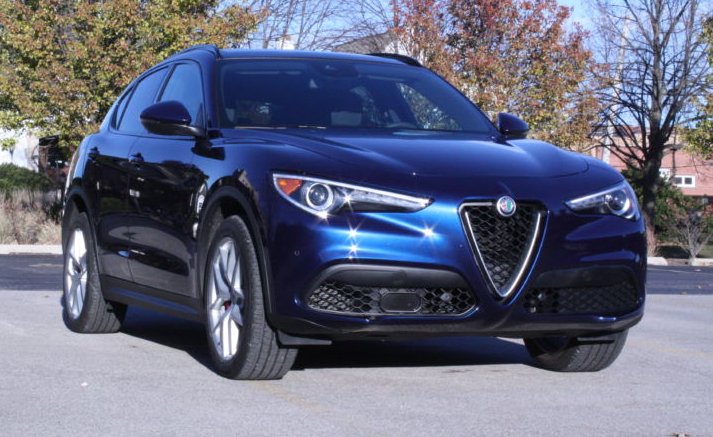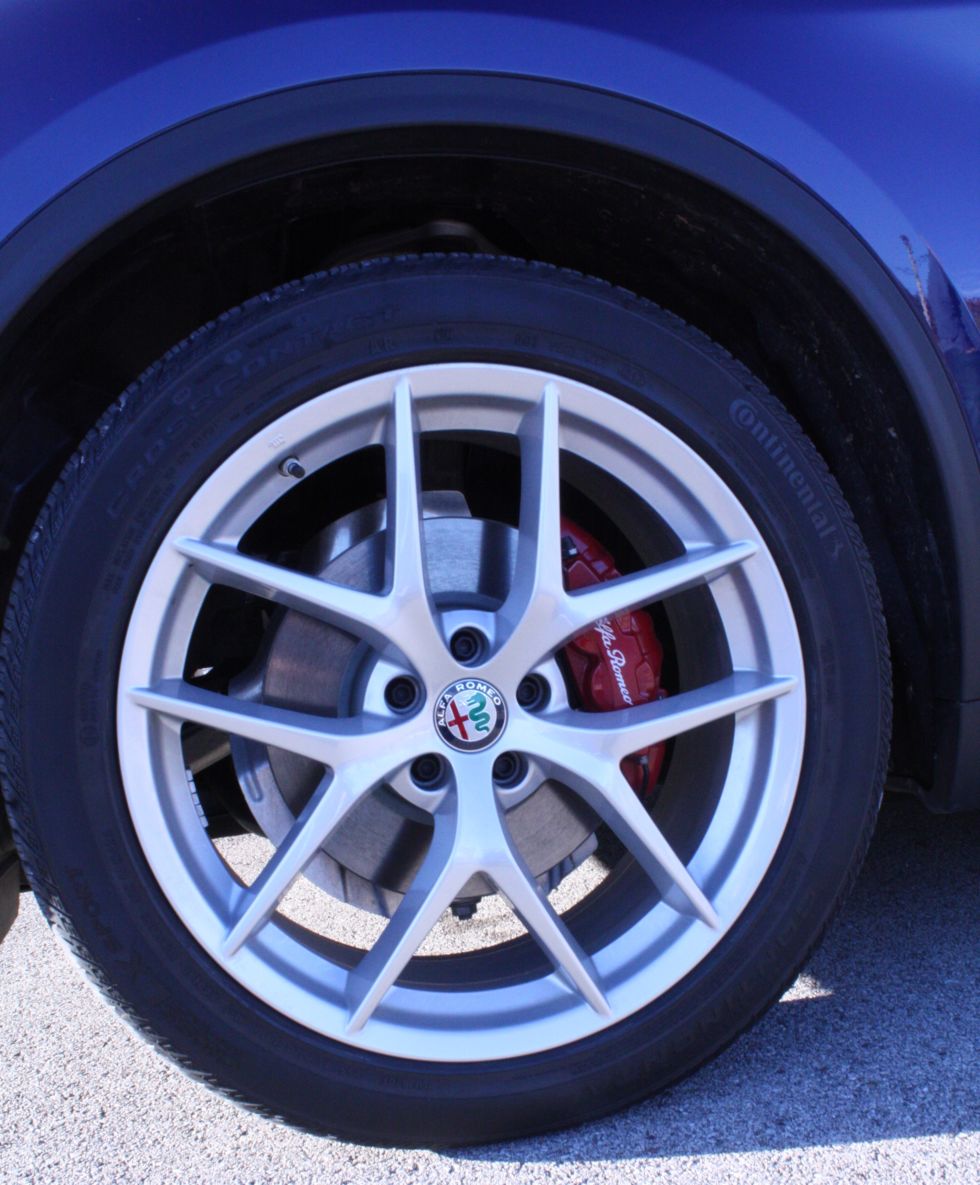
19In 1995, after years of declining sales, Alfa Romeo stopped selling its 164 sedan and said goodbye to the US market. Fans of the Italian automaker—and I count myself among them—were crushed. I’ve owned a pair of Spiders—a 1973 and a 1982—and was once a card-carrying member of the Alfa Romeo Owners Club. American Alfa fans watched from afar as the company continued launching new vehicles in Europe, hoping that the iconic badge would cross the Atlantic once more.
Those hopes came to fruition a few years ago when Fiat Chrysler Automobiles, which owns Alfa Romeo, began selling the 8C Competizione and a new 4C Spider. But if you want to crack the American market, you’re going to need more than a pair of pricey roadsters. Earlier this year, we reviewed the Giulia Quadrifoglio, Alfa’s performance sedan, which my colleague Jonathan Gitlin reckons is one of the best cars he has driven this year. Convincing the folks who usually shop at Audi, BMW, and Lexus dealerships to take Alfa Romeo seriously requires more than a sporty sedan, however. That’s where the Stelvio comes in.Named after an Italian mountain pass, the Stelvio marks Alfa Romeo’s first crack at the crossover/mini-SUV market in the US. I’m the closest thing Ars has to a crossover fan, as I’ve owned a Chrysler Pacifica (the crossover model built from 2004 to 2008) for a decade. I even have experience with what is arguably the first crossover, the AMC Eagle, after inheriting one my grandmother was no longer able to drive. (The less said about that car, the better.)
A peek under the hood
-
The Alfa Romeo Stelvio.Marlowe Bangeman
-
Ready to pounce.Marlowe Bangeman
-
Rear view of the Stelvio in Monte Carlo Midnight Blue.Marlowe Bangeman
-
There's a four-cylinder, 2.0-liter engine under there.Marlowe Bangeman
-
It wouldn't be an Alfa without the circular badge and distinctive grill.Marlowe Bangeman
Alfa has equipped the Stelvio with an aluminum 2.0-liter, turbocharged four-cylinder engine. Those four cylinders churn out 280 horsepower, 306ft-lb of torque, and a top speed of 144mph. More impressive, Alfa claims the Stelvio can go from zero to 60mph in just 5.4 seconds. After several days behind the wheel, I have zero reason to doubt that number.
If that’s not enough for you, there’s a Stelvio Quadrifoglio coming in the next couple months. Alfa hasn't officially confirmed the price, but the more-expensive Quadrifoglio will rock a 2.9-liter twin-turbo V6—closely related to the V8s now used by Ferrari (those puppies crank out 505hp with a top speed of 177mph). The Quadrifoglio will be the fastest SUV on the market, says Alfa.
But we’re not here to talk about $75,000 crossovers. The Stelvio comes with an MSRP of just under $44,000. The model I’ve been driving—the Stelvio Ti Sport AWD—includes the sport package, cold-weather package, and driver-assist package. All that brings the sticker price to $53,640, which compares favorably with the BMW X3, Audi Q5, Lexus RX 450, and others of its ilk.
The Stelvio has all-wheel drive but is effectively a rear-wheel drive car most of the time, with 90 percent of the power going to the rear axle under normal conditions (Correction: 100 percent of the power can go to the rear wheels, according to Alfa). When needed, up to 60 percent of that power is directed to the front axle for a true AWD experience. The Ti Sport comes with the optional 20-inch aluminum wheels, and the bright red brake caliper with the Alfa Romeo logo is visible between the spokes.
At first glance, the Stelvio is an eye-catcher. The front end borrows heavily from the Giulia, with the iconic badge and heart-shaped grill. It has sleek lines with pleasing curves, and I noticed the occasional head turn in parking lots and on the road. Ground clearance is slightly less than other, comparable crossovers, but I have a hard time imagining doing serious off-roading in the Stelvio. This is a car you're going to drive past the dirt road to the riverside campsite, instead heading straight to the lodge at the top of the mountain. And you’re going to enjoy every minute of the drive.
An inconsistent interior
-
The sport seats could be a bit more substantial.Marlowe Bangeman
-
You can fold up the armrest/cupholder combo and put a very small person there.Marlowe Bangeman
-
There's plenty of cargo room, although it would be nice if the rear seats folded down fully.Marlowe Bangeman
-
The steering wheel and instrument cluster. You can see the gigantic metal paddle shifters lurking in the background.Marlowe Bangeman
-
Cruise control on the left and phone/radio controls on the right.Marlowe Bangeman
-
A view of the center console. The large dial is the main control for the MMI, with the drive selector to the left.Marlowe Bangeman
-
Scrolling through the manual.Marlowe Bangeman
-
There's an electronic version of the manual on the MMI—a nice touch that saves digging through the glove box.Marlowe Bangeman
-
The MMI in split screen mode. Changing songs or artists is a bit of an ordeal with the clickwheel.Marlowe Bangeman
-
Adaptive Efficiency mode, which offers optimal fuel economy.Marlowe Bangeman
The Stelvio is a really odd mixture of sleek and mundane once you plop yourself down in the driver's seat. The dashboard sports some cool carbon-fiber trim, but the dashboard material itself is a rubbery material that would feel more at home in a $20,000 econobox than a $50,000 luxury crossover. The hand-stitched, racing-style seats are easy on the eyes, but they feel a little insubstantial. If you’re on the brawny side and not used to the style, you might find them uncomfortable at first. My wife, who weighs about 125lbs, also found them somewhat confining. But I got used to the seats as the miles ticked by. There’s plenty of headroom, unless you’re 6’6” like my videographer.
The bench-style back seats are truly basic and cannot be adjusted at all. There’s a middle seat, but I don’t think anyone over the age of eight would enjoy sitting there. If only two passengers are in the back seat, the middle part folds down, offering a pair of cup holders and an armrest. Leg room is adequate, helped by the curvature of the front seats.
The cargo area is adequately voluminous, and with the rear seats folded down as far as they go—not fully flat, mind you—you can stuff a bunch of luggage, boxes, or whatever you want back there. Suburban parents who need to chauffeur a couple of kids and all their gear will have no complaints.
The instrument cluster and multimedia system are a mix of bad and not-so-bad. The instrument panel has a screen between the speedometer and tachometer that can show speed, trip info, current mileage, and the like. It’s fine. The multimedia interface is not.
The Stelvio’s multimedia display features a standard 6.5-inch screen; the one I drove had the upgraded 8.8-inch screen. It’s a sharp-looking display, but navigation is clunky. Entering an address into the GPS is an ordeal of turning and clicking a large wheel. There’s no touchscreen Uconnect like in Fiat and Chrysler models. And you can’t yet bypass Alfa’s infotainment system in favor of CarPlay or Android Auto—support is coming within the next few months, according to Alfa. The whole thing is not terribly intuitive, and a $44,000 car deserves better.
Out on the road
The Stelvio offers three driving modes: Dynamic, Natural, and Advanced Efficiency. Advanced Efficiency attempts to maximize fuel economy, while Natural gives you that smooth, steady luxury crossover ride. Dynamic mode—well, that gets my adrenaline surging.
In Dynamic mode, shift points are delayed a bit, and stepping on the gas is immensely rewarding. The engine sounds glorious, and the car just flies. The handling is rock solid, too. The more time I spent behind the wheel of the Stelvio, the happier I was.
On winding country roads, I always had the feeling of being glued to the pavement, even when singing around curves. The sight lines are good with the exception of the rear window, but the standard backup camera makes up for the small rear window when reversing. As the Stelvio sits lower than other crossovers—such as the Chrysler Pacifica I've owned for years or, say, an Audi Q5 or Q7—I was never left wondering where, exactly, the front end of the car was.
If you want to go manual, you can use the gigantic metal paddles behind the flat-bottomed, leather-wrapped steering wheel to cycle through the eight-speed transmission. The only time I tend to use those is when going downhill in the mountains, and the Stelvio has a special downhill cruise-control setting. (As I live in the second-flattest state in the US, I was unable to find a hill to test the downhill cruise on.) The paddles work well if manual shifting is your thing, but I’d prefer something smaller; the paddles completely obscure the turn signal and windshield wiper levers.
Alfa’s driver-assist package works as advertised. It includes adaptive cruise control and lane-drift warnings. I enjoyed driving 20 or 30 miles on the interstate with my foot touching neither accelerator nor brake. The lane-departure warning mechanism can be activated at 37mph. If you drift onto the shoulder or into another lane without activating your turn signal, you’ll be greeted by three jarring buzzes. An indicator in the instrument cluster shows when lane departure is active, but if you’re on a road with faded lane markings on a sunny day, the Stelvio may not be able to perceive the lane markings. And it won’t do anything to keep you in your lane—it will just warn you when you drift. There's also a small, triangular light in the sideview mirrors that illuminates when a car is in or close to your blind spot. Unlike Audi, which requires you to select the Prestige package and spend an additional $1,800 to get the full driver-assist package, on the Stelvio it's a $1,500 option for any model.
Alfa advertises 22mpg in the city, 28mpg on the highway, and 24mpg combined. That jibes well with what I saw driving it—I was consistently in the 27-28mpg neighborhood on the interstate and around 21-22 tooling around town.
It’s definitely an Alfa—with all that entails

Alfas have a reputation for being quirky and idiosyncratic cars. In my experience owning two Spiders, I can vouch for that. And the Stelvio has a few quirks of its own. The first time I had it on the highway, there was a bit of wind noise that had me checking to see if all the windows were rolled up. The parking sensors work well, but they sometimes insisted on blaring at me even after I put the car into park. And one time, after starting the car, it immediately reminded me that the wall I had parked in front of was still there. The door-lock button on the exterior didn’t always register my button presses. To minimize fuel consumption, the engine will shut off when you've come to a complete stop at an intersection. A few times, the engine took just a bit longer to restart than I would've liked.
Despite all that, I developed a strong affection for the Stelvio in the week I spent with it. It has its idiosyncracies, there are some odd choices in the interior, and I’d frankly like more comfortable seats. But driving it is incredible. Zipping down the highway brought back happy memories of being behind the wheel of my Spider. The acceleration is exhilarating, the handling is tight, and there’s lots of fun to be had. In the crossover space, it may be a bit of an odd bird. But if you’re in the market for something you can haul a couple of kids and their gear, and you don’t want to sacrifice a fantastic driving experience to the gods of domesticity, the Stelvio might very well be the car for you.
reader comments
74